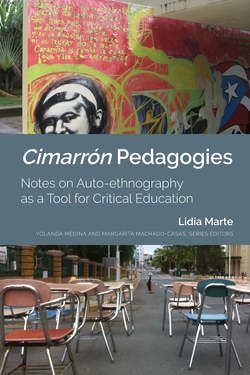Читать книгу Cimarrón Pedagogies - Lidia Marte - Страница 15
Description of Contents and Summary of Chapters
ОглавлениеThe contents of the book are organized into chapters; the first two chapters give an overview discussion of ethnographic methodologies, and the last two chapters ground that discussion through testimonial accounts of my use of auto-ethnography, of research-centered teaching and my approach to critical education. The Appendix offers examples of teaching materials, for those who wish to test-drive some of these tools. Below I share a summary of each chapter to help readers locate materials of their interest. It is my hope that each chapter could stand on its own, but also to work as complement with each other. Although certain points of discussion return in all chapters, this is not a repetition but rather a reiteration in a different way of areas that are related. The very core of this book rests on the use of an auto-ethnographic perspective, hence all throughout, I use first person voice to ground more academic discussions through my own testimonial narratives.
←5 | 6→
Chapter One: “What is Ethnography? Qualitative Methodologies and Academic Narratives.” The focus of this chapter is to explain, for a broader audience, what is ethnography. I begin with basic definitions and characteristics of ethnographic fieldwork and describe, from my perspective as a critical feminist ethnographer, some of the most relevant transformations of this methodology, through a discussion of genealogy of scholars who have been important in my own formation as an anthropologist. This chapter is necessary to understand the development and current status of auto-ethnography.
Chapter Two: “Critical Auto-ethnography: Mapping Personal Root and Routes through ‘Native’ Ethnography.” In this chapter I explain some basic definitions of auto-ethnography as a fieldwork methodology and the most basic approaches to its use. I include a brief review of scholars and examples of works using this methodology, particularly those articles that I assign in my courses. I offer also a discussion of my own definitions and approaches to auto-ethnography as a perspective and a political project and evaluate what I believe are its contributions to my teaching. In closing, I discuss research-centered and place-based education, as necessary context to help students produce grounded auto-ethnographic projects and more critical personal narratives.
Chapter Three: “Critical Auto-ethnography in the Classroom: Auto-ethnographic Projects, Toolkit for Critical analysis and Course Design.” This chapter describes the auto-ethnographic project that I assign, how it is completed throughout the semester, and evaluates the significance of students’ final reports. I also include three more sections related to course design: (a) Discussion of theoretical concepts that I teach, to help students engage in critical analysis of their auto-ethnographic data and to produce final reports that go beyond personal narratives; (b) Description of the supporting coursework and classroom dynamics that support the completion of the projects; (c) Testimony of my experiences using auto-ethnographic methods to teach different courses, in different kinds of colleges, and to diverse groups of students, as well as outside formal education. The overall goal of this chapter is to evaluate the use of the auto-ethnographic methodology, how it helps in meeting SLOs (Student Learning Objectives) for courses, for students to value their own personal histories, develop critical and scholarly skills, as well as “social capital” to know their civil rights and to engage more effectively with political issues in their localities.
Chapter Four: “Cimarrón Pedagogies: Marronage, Critical Education and Liberation Paths.” In this chapter I explain what is meant by the book’s title and the term cimarrón, offering a brief overview of the ethno-historical context of plantation slavery that framed marronage in the Caribbean, and the significance of an African Diaspora and racial literacy to best engage with radical post-colonial ←6 | 7→pedagogies. I offer a sort of genealogy of teacher-mentor-scholars who, through their work and example, helped me to develop and to commit to an eco-feminist pedagogy. I close with some reflections on my auto-ethnographic “cimarrón” strategy, and why this approach results in a critical education, with potential for healing and liberation.
Bonus Track: “Mapping the Calendars of My Educational Roots and Routes,” as the title suggests, it could be an optional reading, yet it offers a detailed explanation of the genesis of my teaching approach, and is a good example of “memory-data” for a potential auto-ethnographic project centered in the topic of education. I have included this part for those readers that might want a more direct grounding of my own educational history. These fragmented auto-ethnographic vignettes trace some roots (origins or earlier educational experiences in DR) and some routes (educational trajectories in Puerto Rico and United States). Warning: This is not a full auto-ethnographic account, since I have not done the research required for such a project, it is rather a collection of “landmark” moments in my formation as a student, teacher and artist-scholar. This piece shows the kinds of—literal and symbolic—movements in how I learned how to learn. I highlight resources, experiences and encounters with my mentors through informal and formal education, to show how I became a college professor, and in a sense, showing the personal reasons for why I use auto-ethnography in my teaching.
Appendix: Teaching Resources, this part contains a sampler of resources that I use in college classrooms, for diverse courses, but all centered around an auto-ethnographic research project. The resources are: auto-ethnographic research project guides, rubrics for assignments, teaching materials, in-class workshops, website links and examples of students’ works. I have also included few handouts, part of the Toolkit for Critical Analysis, that I assign to students, to teach them theoretical concepts useful for the analysis of their auto-ethnographic project data. This appendix is provided to support the discussion in Chapter Three, and to give access to readers/users to teaching materials. These could be simplified and tailored to particular needs, if someone wish to test-drive auto-ethnographic approaches (an email address is also provided, if they wish to share feedback about their experiences).
